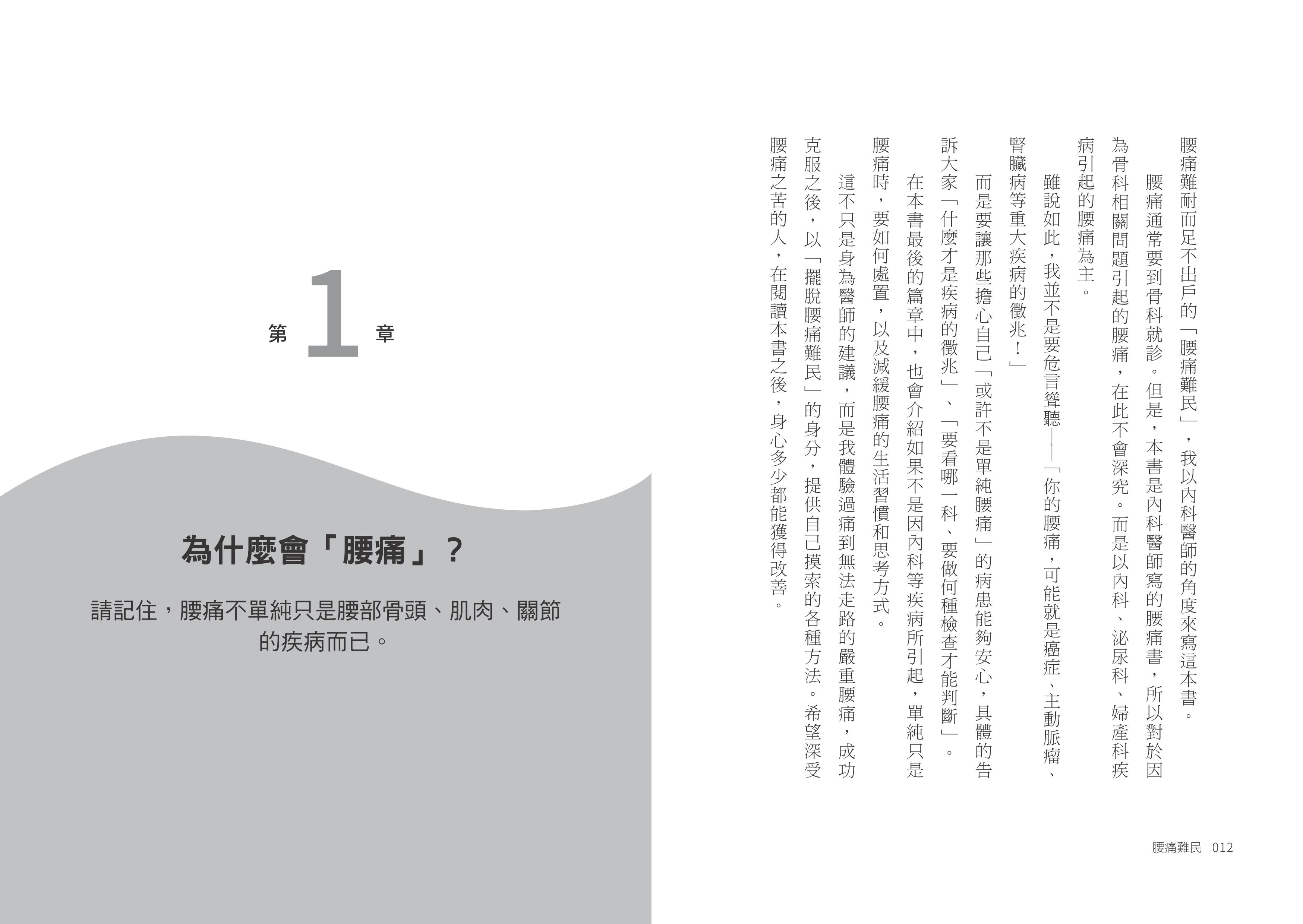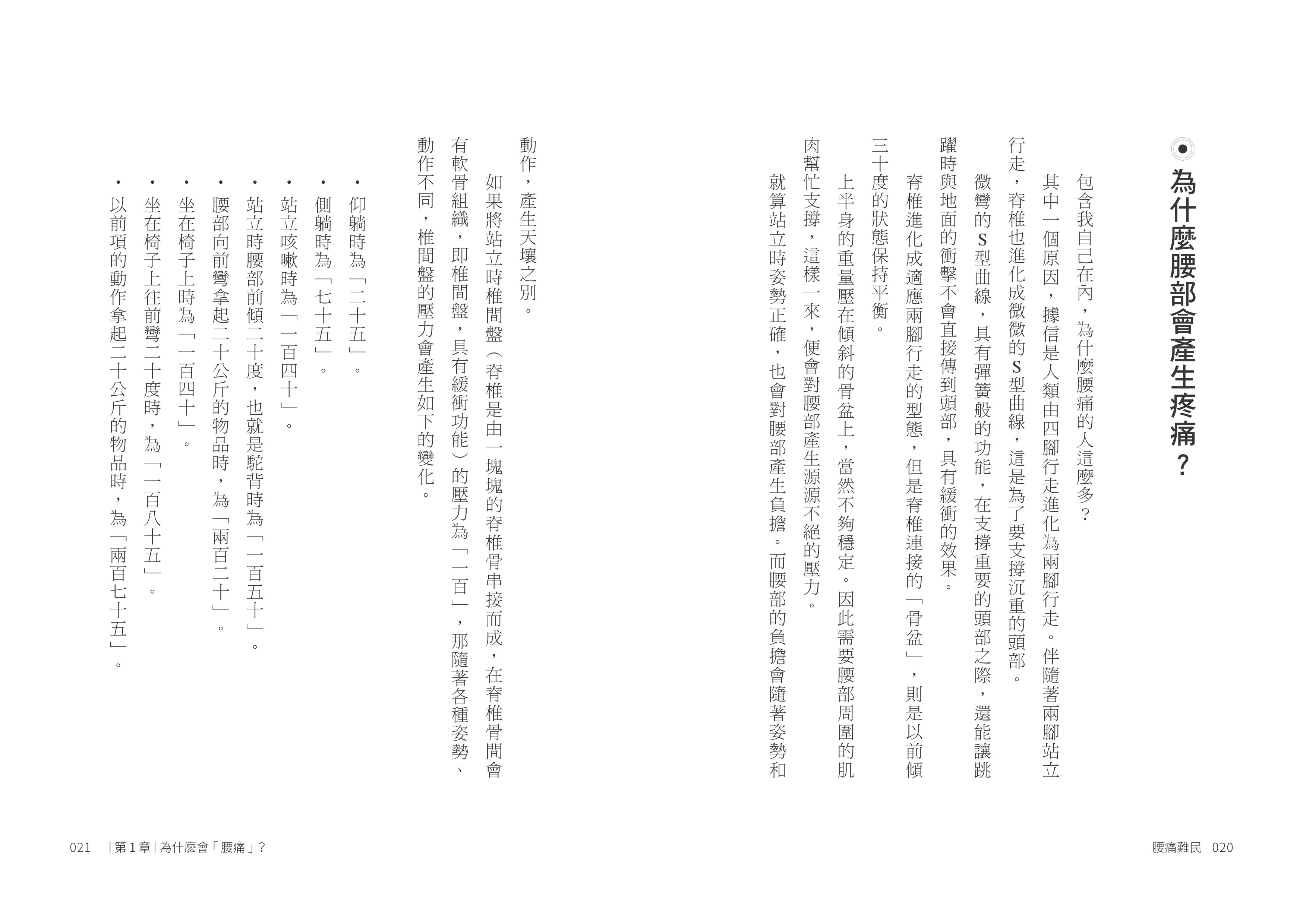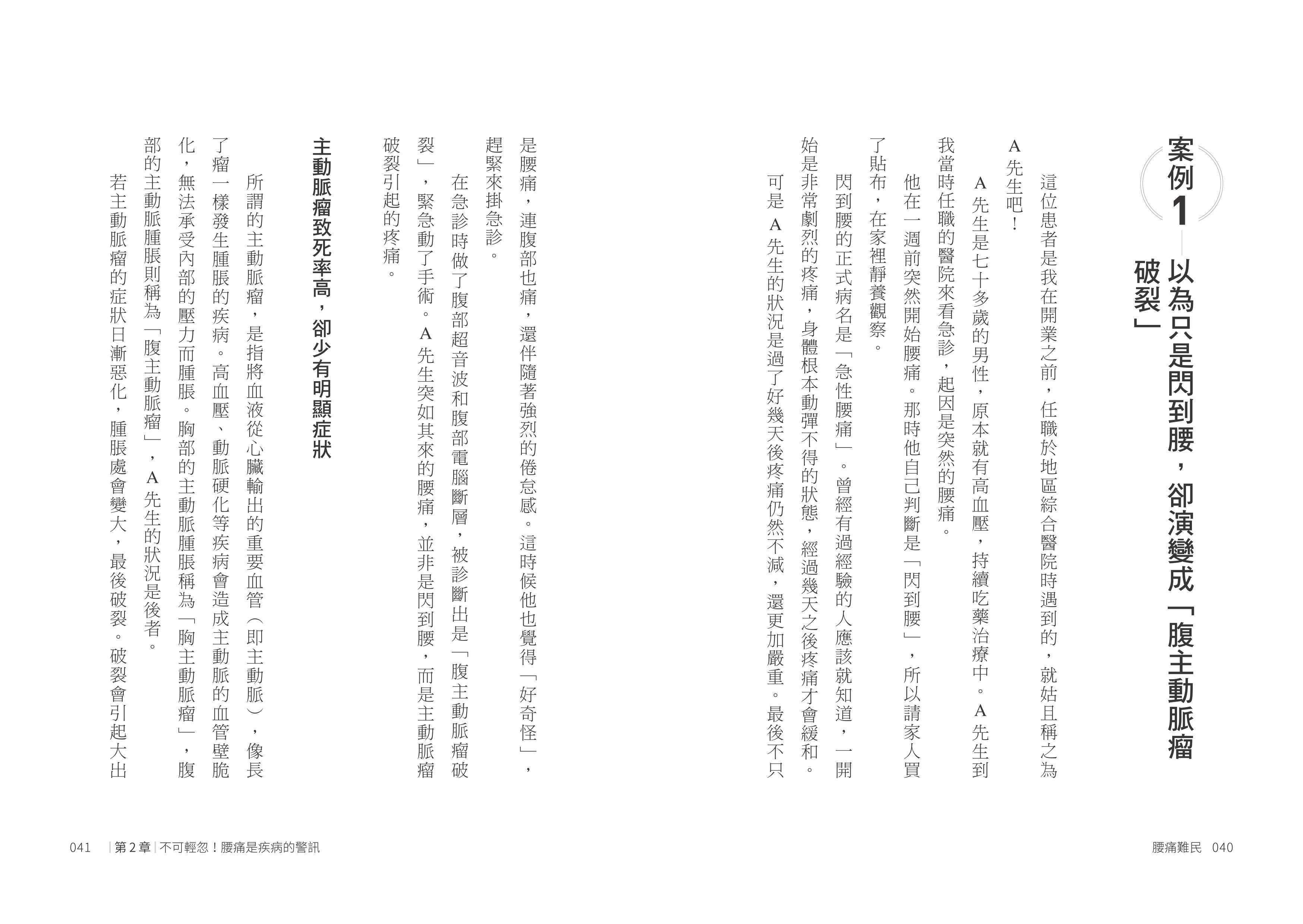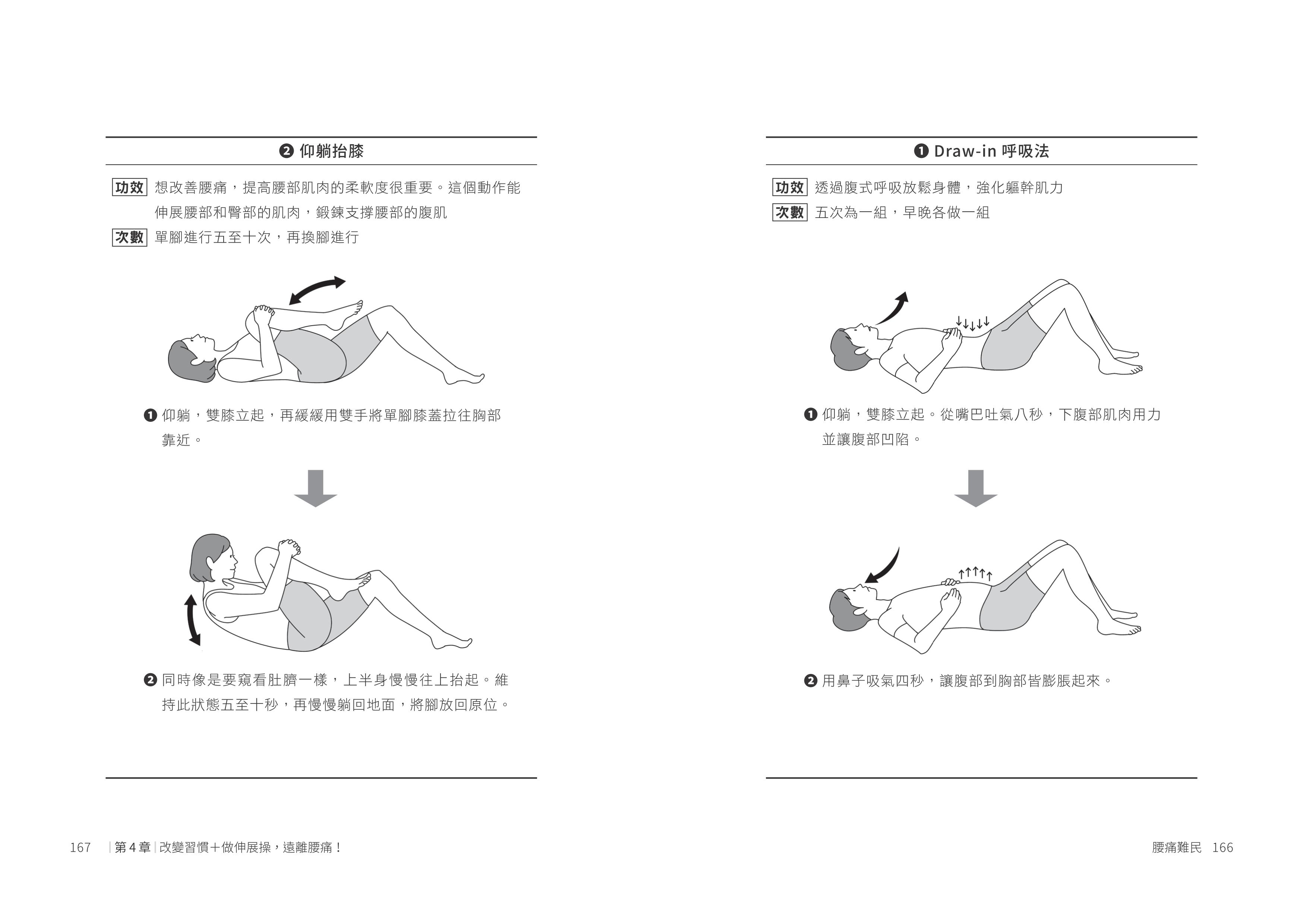
| Chinese Title |
Back Pain Refugees:好不了的腰痛,可能是重大疾病的徵兆! |
| Original Title |
Back Pain Refugees その痛みは、本当にただの腰痛なのか |
| Author |
池谷敏郎 |
| Translator |
張佳雯 |
| Series |
健康力 |
| Publisher |
Publication Date |
| Publication Date |
2022/02/10 |
| EAN |
9789570861846 |
| Book Dimensions |
21 cm (L) × 14.8 cm (W) × 1.2 cm (H) / 200 pages |
| Printing |
Paperback / 25K / Black and White Printing |
Content Summary
Long-term lower back pain that just won't go away?
There are many causes of lower back pain, not just muscular aches!
Exclusive insights from a renowned Japanese internist reveal that emotions, personality, and even weather can trigger pain!
──Includes lower back stretching exercises, four movements to heal chronic lower back pain.──
Are you someone trapped in lower back pain but can't seem to find the cause?
This book is written for the following individuals:
• Those who have visited orthopedics for lower back pain but haven't healed.
• Those who have tried massage for lower back pain without improvement.
• Those who have experienced lower back pain for over a month.
• Those whose lower back pain has occurred suddenly without any injury.
• Those worried that their unexplained lower back pain might be due to another disease...
If long-term lower back pain doesn't heal, it's highly likely caused by another disease. "Lower back pain" is just an external symptom!
★ The lower back is an organ that speaks; often, it's a sign of a serious illness.
Although Dr. Toshiro Iketani is an internist, he frequently encounters patients with lower back pain in his practice. In fact, among every three patients, one suffers from lower back pain. It's not uncommon for other diseases to be diagnosed due to lower back pain, such as kidney stones, shingles, or bone metastasis from cancer. Rather than worrying that "maybe it's not just lower back pain," it's advisable to thoroughly identify the cause and undergo appropriate treatment.
In his book, Dr. Iketani explains specifically which types of lower back pain are signs of disease, which medical specialty should be consulted for lower back pain, and what tests should be performed to determine the cause of lower back pain. This helps everyone correctly identify and receive treatment for their condition.
★ Improving lower back pain involves mastering three key principles for effective pain relief
Dr. Iketani, who has experienced chronic lower back pain himself due to prolonged sitting during consultations and obesity, understands the impact it can have on daily life. As someone who has been through it, he offers the following advice to those suffering from lower back pain:
1.Undergo Comprehensive Examination
Start with a visit to an orthopedist. If the cause isn't identified there, seek treatment from relevant specialists based on the location of the pain.
2.Keep a Lower Back Pain Diary
Record daily details such as the location, intensity of pain, and emotional state to help identify the underlying causes of the pain.
3.Engage in Lower Back Pain Stretching Exercises
Instead of resting in bed all day, perform daily stretching exercises to strengthen muscles and improve pain management.
If you are someone deeply troubled by lower back pain, after reading this book, you can expect both your physical and mental well-being to improve significantly.
The book features
1.Explanations of Lower Back Pain Causes from an Internal Medicine Perspective.
2.Inclusion of Various Lower Back Pain Cases.
3.Unique Stretching Exercises Developed by the Physician.
Endorsements from Prominent Experts in Taiwan
王偉全 (Wang Wei-Chuan): Director of Super Multi-Specialty Clinic and Chairman of the Taiwan Society of Andrology Medicine.
林頌凱 (Lin Sung-Kai): Director of United Hospital International Clinic.
侯鐘堡 (Hou Zhong-Bao): Former Director of Original Force Rehabilitation Medicine Department.
詹珞瑤 (Zhan Luo-Yao): Head of Zhi Xin Physical Therapy Clinic and YouTube Channel Operator.
──These experts collectively recommend the book for its comprehensive insights into lower back pain management.
High praise recommendation
Back pain is a mystery! Back pain refugees struggle with imaging diagnostics, yet often in vain. Dr. Ikuya firmly reveals the secret methods to you.──Wang Weiquan,Director of Super General Clinic and Director of Taiwan Regenerative Therapy Medical Association
Back pain is one of the most common sources of bodily discomfort. This book can help you systematically care for your body, preventing you from becoming a back pain refugee.──Lin Songkai, Director of Lianxin International Clinic
The causes of chronic back pain are extremely complex and prevalent, covering issues like kidney problems, lumbar vertebrae, and muscle ligaments. Caution is advised!──Hou Zhongbao, Director of Original Force Rehabilitation Clinic
Chronic back pain is typically caused by more than three factors, which could be related to posture, emotions, or internal organ issues! Those experiencing back pain for more than three months should further understand the reasons mentioned in the book to effectively manage their pain.──Zhan Luoyao, Responsible Person of Zhixin Physical Therapy Institute and YouTube Channel Manager
Contents
- 【Foreword】Persistent Lower Back Pain Could Be a Symptom of a Serious Illness
-
Chapter 1 Why Do We Experience "Lower Back Pain"?
- Remember, lower back pain is not simply a condition of the bones, muscles, and joints in the lower back.
- One out of every three outpatient visits involves complaints of lower back pain.
- Being overweight and sitting for long periods, even in my thirties, I also experience lower back pain.
- Why does the lower back experience pain?
- There are many causes of lower back pain, not just joint and muscle pain.
- There are three main "orthopedic diseases" associated with the lower back.
- Up to 80% of lower back pain cases have unknown causes.
- Lower back pain without an identifiable cause can be unsettling.
-
-
Chapter 2 Do Not Underestimate It! Lower Back Pain is a Warning Sign of Disease
- Because lower back pain is so common, it is easy to dismiss it as a "recurrence of an old problem."
- 【Case 1】Thought it was just a pulled muscle in the lower back, but it turned out to be a "ruptured abdominal aortic aneurysm."
- 【Case 2】Sought massage therapy for lower back pain, only to discover "cancer metastasis to the bones."
- 【Case 3】 Initially unexplained lower back pain, which eventually led to "pyelonephritis."
- 【Case 4】Believed it was irritation from a patch causing lower back pain, but upon examination, it was "shingles."
- 【Case 5】When stress cannot be relieved, it can also lead to "psychogenic lower back pain."
- 【Case 6】Lower back pain that does not improve even with painkillers and gastric medication.
-
Chapter 3 Avoid Becoming a Lower Back Pain Refugee – Specialists and Tests You Should Consider!
- Accurately conveying necessary information can enhance the precision of medical diagnosis.
- About one-tenth of lower back pain patients are diagnosed with other diseases.
- Spending just a minute lying down can distinguish between "pulled lower back" and "visceral disease"!
- For chronic lower back pain, it is advisable to first seek treatment from an orthopedist.
- Developing a habit of self-examination during normal times can help detect cancer metastasis to the bones early.
- When treatment from an orthopedist does not improve the condition, consider these tests.
- Through the "medical grading" system, seek treatment at an appropriate institution.
- When unsure of the cause of lower back pain, consult a family doctor.
- There are also techniques for explaining symptoms that can help doctors determine the severity of the condition.
- How should you use pain relief patches when experiencing lower back pain?
- Chiropractors and massage therapists are not doctors and should not diagnose diseases indiscriminately.
- Starting from posture and habits is the key to truly improving lower back pain.
-
-
Chapter 4 Changing Habits + Doing Stretching Exercises to Keep Lower Back Pain Away!
- Chronic lower back pain is less about "who treats it" and more about "how you handle it yourself."
- The more you worry, the worse your lower back pain becomes.
- Certain thoughts or actions can easily lead to "chronic lower back pain."
- Writing a "lower back pain diary" effectively improves pain.
- Does lower back pain recur once the weather changes?
- Does pursuing perfectionism make lower back pain worse?
- For treating chronic lower back pain, "exercise" is the first choice.
- In addition to treatment, lower back pain also requires independent exercise.
- Doctor's original creation! "Iketani-style Lower Back Pain Stretching Exercises" suitable for chronic lower back pain.
- 【Exercise 1】Draw-in breathing technique.
- 【Exercise 2】Lying knee lift.
- 【Exercise 3】Bridge position while lying down.
- 【Exercise 4】Prone upper body lift.
- Recommended by Dr. Iketani! Adjusting daily habits to alleviate lower back pain.
- There are tips for sitting posture to make your lower back more comfortable.
- To prevent prolonged sitting, choose a firmer chair.
- To prevent prolonged sitting, choose a firmer chair.
- 【Afterword】Finding the cause behind lower back pain is the true path to pain relief.
Author Bio
Author:池谷敏郎(Toshirou Iketani)
Medical Doctor.Born in Tokyo, Japan in 1962. Graduated from Tokyo Medical University Faculty of Medicine in 1988. Following graduation, he joined the Second Department of Internal Medicine at Tokyo Medical University Hospital, focusing on the relationship between blood pressure and arteriosclerosis. In 1995, he established Ikuta Hospital where he serves as the chief physician in internal medicine and cardiovascular medicine. In 1997, he became the Chairman and Director of Ikuta Hospital, a medical corporation. He continues to practice in the forefront of clinical medicine, treating patients.
Dr. Iketani is certified by the Japanese Society of Internal Medicine as a specialist in comprehensive internal medicine, and he is also certified by the Japanese Circulation Society as a specialist in cardiovascular medicine. Additionally, he serves as a visiting lecturer in cardiovascular medicine at Tokyo Medical University. He has authored several works including "Shake off Visceral Fat in 15 Days" and "Exercise Peripheral Blood Vessels, Lower Blood Pressure Slowly!
Translator:張佳雯(Chia-Wen Chang)
Chia-Wen Chang graduated from the Department of Japanese Language and Literature at Fu Jen Catholic University. She has worked in various roles including at magazines, publishing houses, and a Japanese technology company. Currently, she works full-time as a translator and interpreter. Her translated works include "56 Original Desserts by the Flat-bottom Pot Snack Magician," "Tokyo New Sensation! Popular Chef's Rice Ball-Free Recipes," "Growing Tall Kids: Boosting Health and Confidence," and "From 40 Years Old, Dietary Changes are a Must," among others.
Foreword
Foreword/Chronic Back Pain That Won't Heal: A Sign of a Serious Illness"My back and waist are both hurting."
This was a male patient around fifty years old who came to my clinic due to hypertension.
He mentioned that his symptoms of back and waist pain started about two months ago. He visited an orthopedic specialist and was prescribed painkillers and muscle relaxants.
However, the pain did not improve despite taking the medication. During the consultation, I asked, "Besides hypertension, are there any other discomforts?" Only then did he...
Serial Content




▮The causes of lower back pain are numerous, extending well beyond joint and muscle discomfort.
When patients mention "lower back pain" during consultations, I notice that there are various types of pain associated with the same term.
Firstly, when they refer to "lower back pain," the specific area they point to varies. Some may describe pain near the buttocks, while others mention near the back or the side of the abdomen.
Those indicating pain "around the lower back" over a broader area might also specify whether it's on the right or left side. Similarly, the types of pain described are diverse. Some say their lower back feels "heavy," "weak," "tight," or "strange," while others describe a dull ache, pain that restricts movement, or makes it uncomfortable to sit.。
The intensity and specific location of the pain vary, but almost all are categorized as "lower back pain." It's because of this variability that so many people identify themselves as suffering from lower back pain.
▮Nerve, visceral, or vascular diseases can also cause lower back pain.
There are many symptoms that can lead to "lower back pain," and the causes are numerous.
Let me briefly explain the structure of the spine (see Figure 2 on the next page). When we talk about the spine, it actually consists of many bones stacked together like building blocks.
Starting from the top, there are seven "cervical vertebrae," followed by twelve "thoracic vertebrae" connected below, and then five "lumbar vertebrae" in the lower back. Each individual bone is called a "vertebra," and extending downward are the "sacral vertebrae" and "coccyx," which together form the entire spine. The spine has three main functions: supporting the body as a pillar, allowing flexibility for bending forward, backward, left, and right, and protecting important nerves.
A single bone that makes up the spine is called a vertebra (see Figure 3 on the next page), consisting of the front "vertebral body" and the rear "vertebral arch," with holes between them. Vertebrae stack up, connecting their respective holes to form a cylindrical structure known as the "vertebral canal," where important nerves like the "spinal cord" and "cauda equina" are located.
In addition, from the cervical vertebrae down to the lumbar vertebrae is the spinal cord, while below that is the bundle of nerves resembling a horse's tail, known as the cauda equina.
Lower back pain arises from disorders affecting the lumbar vertebrae or irritation of nearby nerves. Regardless of the specific condition, there are numerous causes of pain.
Apart from the musculoskeletal components surrounding the spine (bones, joints, muscles, nerves, etc., facilitating body movement), lower back pain can also result from neurological, visceral, vascular, and psychological conditions.
Figure 4 on the previous page provides a clear overview: the "spine and its surrounding musculoskeletal organs" are interconnected, with diverse causes that extend beyond just orthopedic diseases.
Among the diseases causing lower back pain are severe orthopedic conditions like "lumbar disc herniation" or "spinal stenosis," which may be accompanied by leg numbness or urinary dysfunction. Additionally, internal medical conditions such as cancer or aortic aneurysm can also manifest as lower back pain.
Remember, lower back pain is not simply a condition of the bones, muscles, and joints in the lower back.
▮When experiencing chronic lower back pain, it's advisable to seek treatment from an orthopedic specialist first.
Chronic lower back pain, or the subtle onset of persistent discomfort, should prompt a visit to an orthopedic specialist.
To clarify, orthopedics primarily addresses issues related to bones, joints, and muscles. When injuries or diseases affect these structures, orthopedic treatment focuses on restoring function.
If you experience back pain, the first step is to consult with an orthopedist. In addition to a physical examination, X-rays or MRI scans may be recommended to identify conditions like herniated discs, spinal stenosis, spondylolisthesis, or osteoporotic fractures that could be causing compression.
Orthopedists are trained to distinguish whether back pain is caused by serious conditions such as cancer metastasis to the bones or spinal infections like pyogenic spondylitis. Prompt identification and treatment of these conditions are crucial as they can rapidly deteriorate over days or weeks.
Therefore, to discern these conditions, the following indicators are considered warning signs that should not be ignored:
• Onset of symptoms below the age of 20 or above 55
• Pain persists even at rest without any activity
• Chest pain
• History of cancer, steroid use, or HIV
• Malnutrition
• Sudden unexplained weight loss
• Extensive neurological symptoms
•Structural spinal deformities (e.g., scoliosis)
• Fever
In children under 20, back pain might result from stress fractures like spondylolysis due to physical activities. Early detection and the use of back braces can lead to recovery. Conversely, individuals over 55 face increased cancer risks. If combined with malnutrition or sudden weight loss, cancer or internal organ diseases should be considered.
Moreover, pain that persists while at rest and is unrelated to movement suggests issues beyond the musculoskeletal system, potentially involving bones, muscles, and joints in the lower back. Concurrent chest pain may indicate myocardial infarction (heart attack). It's worth noting that myocardial infarction pain is commonly known to radiate to the shoulders and neck.
Long-term use of steroids increases the likelihood of osteoporosis, while HIV patients are also at higher risk of osteoporosis and pyogenic osteomyelitis.
Extensive neurological symptoms refer to tingling, numbness, weakness in the legs, or abnormal sensations during urination or defecation. Structural spinal deformities encompass conditions such as scoliosis (sideways curvature of the spine) and kyphosis (excessive backward curvature of the spine).
...











